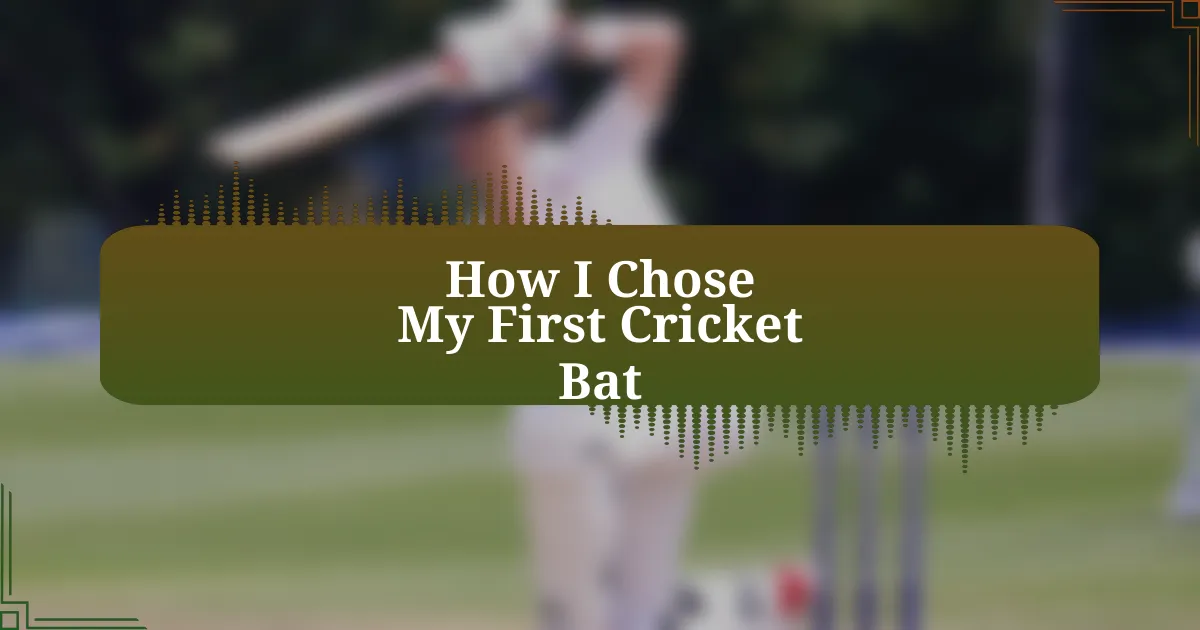Key takeaways:
- Weight and size of the bat are crucial for balancing power and control; personal preference plays a significant role.
- Understanding bat materials (willow vs. hardwood) and grades affects performance and longevity; higher-grade bats offer better responsiveness.
- Choosing the right bat can dramatically enhance confidence and connection to the game; experimenting with different bats is vital.
- New buyers should prioritize comfort and fit when selecting a bat and consider investing in quality for improved gameplay.
Author: Evelyn Harper
Bio: Evelyn Harper is an award-winning author known for her evocative storytelling and rich character development. With a background in psychology, she weaves intricate narratives that explore the complexities of human relationships. Her debut novel, “Whispers in the Wind,” received critical acclaim and established her as a fresh voice in contemporary fiction. A graduate of the Iowa Writers’ Workshop, Evelyn resides in Portland, Oregon, where she continues to write and inspire aspiring authors through workshops and mentorship. When not immersed in her writing, she enjoys hiking the Pacific Northwest trails and sipping coffee at local cafes.
Factors affecting bat selection
When choosing my first cricket bat, I quickly realized that weight was a crucial factor. A heavier bat can provide power, but I found I preferred a lighter option that allowed for quicker swings. Have you ever struggled to find that balance between power and control when selecting equipment? It’s a common dilemma.
The size of the bat made a big difference too. Initially, I thought a longer bat would be best for my height, but I learned that it also required more precision in my shots. Reflecting on my early days, I often wondered if I made the right choice based solely on appearance rather than feel. It’s important to hold the bat and get a sense of how it fits with your style.
Another key element I considered was the bat’s profile and its sweet spot. I remember swinging a few different models at a local sports store, and the moment I struck a ball perfectly, it felt magical. This personal connection to the bat’s performance made me realize that finding the right profile could genuinely enhance my confidence during matches. Have you experienced that thrill of connection during practice? It’s those moments that make us appreciate every choice we make.
Understanding bat materials and types
Understanding bat materials and types plays a pivotal role in making the right choice. I discovered that there are mainly two types of wood used for cricket bats: willow and hardwood. While willow is preferred for its lightness and shock absorption, hardwood bats, although heavier, can deliver a unique feel and power. Do you remember your first encounter with different bat materials? I felt like a kid in a candy store, overwhelmed but excited to learn.
As I delved deeper, my research revealed the significance of bat grades, which refer to the quality of the willow. Higher-grade bats tend to have fewer knots and blemishes, offering better performance and longevity. I remember when I invested a bit more to get a Grade A bat; every shot felt more responsive, and I could really sense the difference in my game. Isn’t it fascinating how tiny details can so profoundly impact our play?
I also found that bat shapes and sizes vary to cater to different playing styles. For instance, there are English and Kashmir willow bats, each offering distinct qualities. After experimenting with various shapes, I became fond of the slightly thicker spine of my favorite bat, which provided a fantastic sweet spot for that satisfying sound when I connected with the ball. Have you ever felt that satisfying resonance? It’s a sound that truly defines a cricketer’s joy and connection to the game.
My personal experiences with bats
When I first started playing, I had this old bat that was handed down to me. It was heavy and unwieldy, making it challenging to swing through the ball. I remember feeling a sense of frustration as I struggled to time my shots correctly. Have you ever been in a situation where your equipment just didn’t match your energy? That bat taught me early on the importance of finding something that feels right for your style.
As I grew more serious about the game, I experimented with different bats, each offering a unique experience. I vividly recall trying a lightweight bat during a practice match; the contrast was incredible. Suddenly, I could maneuver with ease and responsiveness, and my confidence soared with each hit. What a revelation! It was a turning point for me, highlighting how crucial it is to choose a bat that harmonizes with your playing style.
Eventually, I settled on a bat that had a perfect balance of weight and grip. The first time I hit a six with it, I can still feel that exhilarating rush. There was something almost magical about that connection between the bat and the ball. Have you ever had a moment like that when you just knew you found the right fit? It’s those experiences that solidify our love for the game and inspire our journey as amateur cricketers.
Tips for first-time bat buyers
Choosing your first cricket bat can be a daunting task, but it doesn’t have to be. I remember staring at rows of bats as a beginner, feeling overwhelmed. One crucial tip is to hold the bat and get a feel for its weight and balance. Does it feel comfortable in your hands? I’ve often found that a bat that feels just right makes all the difference in my performance.
Another essential consideration is the size of the bat. When I first bought a bat, I underestimated how much difference the length could make. It should ideally come up to your waist when standing vertically. If it’s too long, you’ll struggle with control; if it’s too short, your reach will be limited. Can you remember the frustration of misjudged swings that could have been easily avoided with the right size?
Lastly, don’t shy away from investing a bit more in quality. I made that mistake early on, opting for something cheaper that quickly fell apart. A good bat is an investment in your game. Think about how often you’ll use it; having a reliable bat will enhance your practice sessions and matches. Have you thought about how a quality bat could elevate your play? It’s worth weighing your options carefully.



